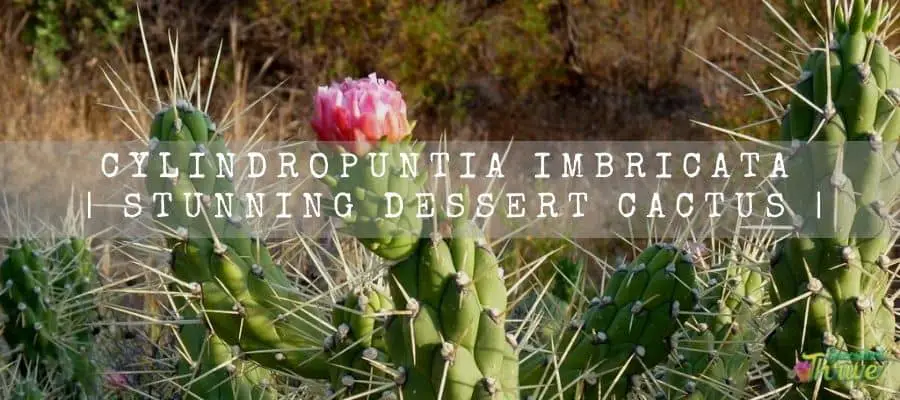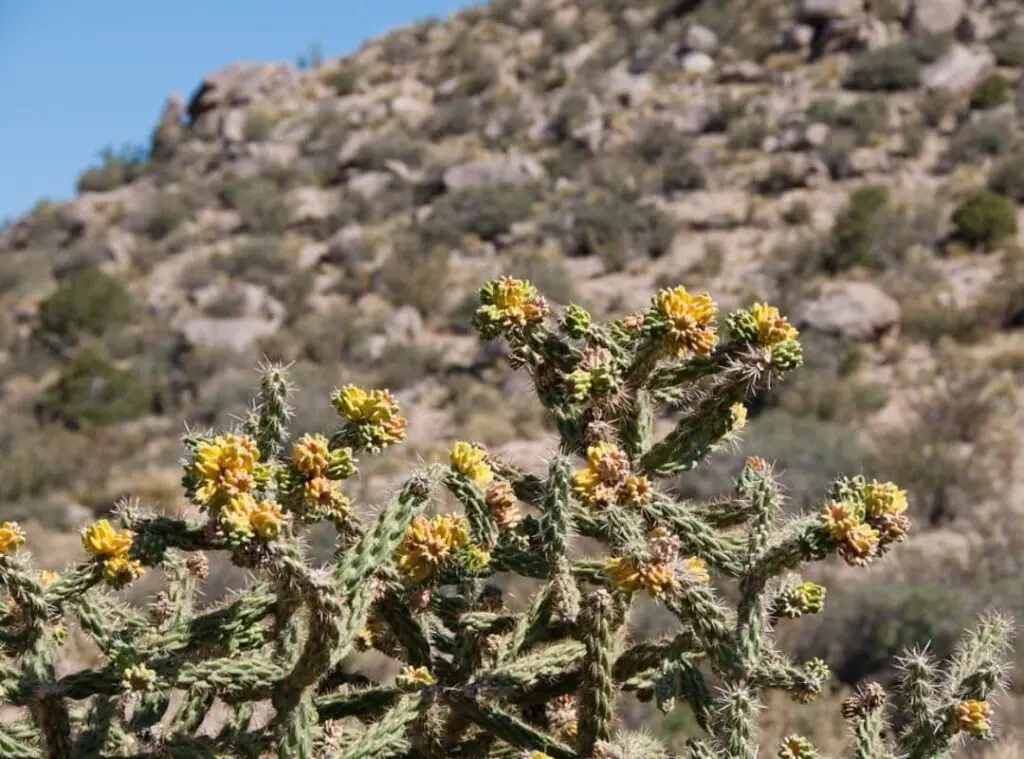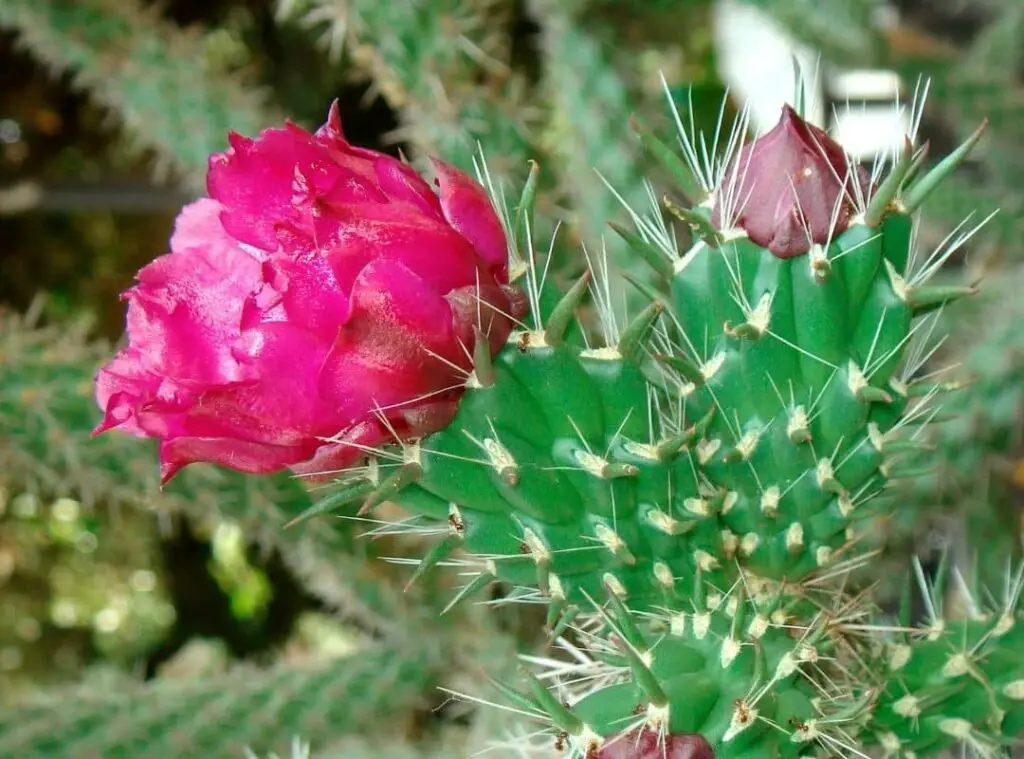Cylindropuntia imbricata are originally from the United States and from Mexico. They would usually form 1200-2400 m above sea level.
These plants would usually form in sandy gravely areas. Many wild birds and mammals tend to eat the Cylindropuntia imbricata fruits as well.
Some of the common names of the Cylindropuntia imbricata are Devil’s rope pear, Devil’s rope cactus, Rosea cactus and so on.
They are some spectacular looking plants and if you wish to cultivate them, you will find this article very useful.
I will be covering the modes of propagating them and the bugs and illnesses they may come across etc.

How do I identify Cylindropuntia imbricata?
You could identify the this plants from their shrubby or tree-like appearance. They further carry some fruit items as well.
In fact, they would emerge with yellow fruits. Cylindropuntia imbricata fruits would take an egg shape. Moreover, they consist of pale brown seeds too.
They develop segments which form with areoles. Those areoles further consist of glochids.
Cylindropuntia imbricata plants carry long spines too. These plants would grow up to 1m in height generally.
However, there could be occasions where they may grow up 4.6 m in height where it will have a diameter of 25 cm.
They emerge flowers in different shades of dark pink and purple. Besides, their stamens would be yellow.
However, Cylindropuntia imbricata would bloom only if they are 60 cm in height only. Cylindropuntia imbricata plants’ durability lasts for 20 years.
Cylindropuntia imbricata stems would form in a branched manner and they would tend to take a cylindrical rope-like shape too.
The stem would be 25 cm in diameter. Further it would be woody and dark gray green in color.
Besides these features, Cylindropuntia imbricata leaves would be 8-24mm in length. Moreover, their areolas would be yellow to tan wool in color.
Further those areolas may consist of small bristles as well. You could spot these plants carrying spines too.
Cylindropuntia imbricata plants further produce flowers in purple or magenta colors. They would be bowl shaped and would be about 4-6 cm in length.
Further those blooms would be 8-9 cm in width as well. Cylindropuntia imbricata emerge with flowers during late spring and summer.
One look care guide
| Botanical Name | Cylindropuntia imbricata |
| Common Name | Devil’s rope pear, Devil’s rope cactus, Rosea cactus |
| Plant Type | Cactus |
| Mature Size | 4.6 m in height / 25 cm in diameter |
| Sun Exposure | Full sunlight to partial sunlight |
| Soil Type | Well-draining / gritty |
| Soil pH | acidic, neutral or alkaline |
| Bloom Time | Spring to summer |
| Flower Color | bright pink to purple |
| Hardiness Zones | USDA hardiness zones 5A 8(-20°F or -28°C). |
| Native Area | The USA and Mexico |
| Toxicity | Not toxic |
| Average price | 5 USD |
How do you take care of Cylindropuntia imbricata?
Light Requirement
Cylindropuntia imbricata plants grow well in full sunlight preferably in the morning hours. In fact, they prefer to have direct sunlight in the morning hours.
Afternoon shade would work well with them, especially during intense hours in summer. Cylindropuntia imbricata would opt to grow closer to a bright sunny windowsill if you wish to grow them indoors.
Temperature and humidity
Cylindropuntia imbricata would flourish if you provide warmer conditions right throughout the year. Having said that, Cylindropuntia imbricata plants can withstand colder weather conditions also.
They are tolerant of some colder weather conditions but not for too long though. Thus, if you expect any frost condition and if you have planted them outdoors, I suppose the best you could do is to bring them indoors as prolonged exposure for frost would be unhealthy for the plant’s wellbeing.
What is special about these plants is that they can tolerate extreme high temperatures as well as colder temperatures.

Is it cold hardy?
Cylindropuntia imbricata are cold hardy plants. They can withstand colder temperatures up to -20 degrees Fahrenheit to – 28 degrees Celsius).
Growth Zone
Cylindropuntia imbricata opt to grow in USDA hardiness zones 5A 8 (-20°F or -28°C).
Watering Requirement
Cylindropuntia imbricata plants have minimal requirements when it comes to watering. Watering them properly is very important in terms of looking after these plants well.
As you may understand these are drought tolerant plants and not the type of plants which would want water in excess.
If you end up watering in abundance it would bring even a lethal impact on the plants. Cylindropuntia imbricata have water conservation in their body and on top of that if you provide more water, it will only result in health deterioration.
I encourage watering them more often during summer while ensuring that you let their soil become dry between two watering sessions.
On the other hand, you need to cut back on watering during high humidity levels and when the temperature is much colder. Further I recommend checking the soil condition before you water them.
Soil Requirement Type / pH
An excellent drainage is a very critical factor when choosing the right soil mix for the Cylindropuntia imbricata plants.
Cylindropuntia imbricata are susceptible to root rot and if you end up using a poor draining soil mix, it will cause root rot.
These plants usually grow in sandy gravelly soil mixes. Hence, I recommend using commercially made succulent soil mix or cactus soil mix as they would perfectly fit for these plants’ vigorous growth.
In terms of the right ph. levels, they would prefer to have an acidic, neutral or alkaline soil mix.
Pot size Potting and Repotting
A terracotta pot or a clay pot would be ideal for these plants. Once you grow them in these pot materials, it would allow the water to evaporate faster.
In addition to the pot material, you need to ensure that they have sufficient drainage as well. In terms of repotting the Cylindropuntia imbricata plants, what you could ideally do is to repot them in spring if you spot their roots have become cramped. Avoid repotting them quite often.
Instead, you could repot them once every two years.Do not water them right after you repotted them as they need some time to adjust to the new growing conditions.
Where to Plant
Cylindropuntia imbricata are hardy plants and they will thrive well if you expose them to sufficient sunlight levels. Hence you need to plant them in a spot where they can absorb the necessary sunlight levels.
Fertilizer and time of year
A typical cactus fertilizer would be ideal to feed these plants. Alternatively, you may also use a water-soluble fertilizer or a granular fertilizer also too.
Never feed them when they are dormant as they would not consume their energy during their dormancy. Instead, you need to feed them when they are actively growing.
Flower
Cylindropuntia imbricata would form bright pink to purple flowers in spring to summer. Those flowers would be bowl shaped. Moreover, pollinators such as hummingbirds are quite attractive for these flowers.

Dormancy
Cylindropuntia imbricata are winter dormant plants.
Toxicity
There is no record of their toxicity.
Common bugs and illnesses
Cylindropuntia imbricata are usually pest resistant. However if you over water these plants it would male the plants vulnerable for many diseases such as root.
Moreover, it would make the plants more vulnerable for fungal and bacterial infections.
Special Care tips
Cylindropuntia imbricata requires a minimum care treatment from you. All you need to assure is that you provide a well-draining soil mix, water them moderately and expose them for sufficient sunlight.
In addition to that it is noteworthy that Cylindropuntia imbricata carry spines and you need to protect yourself when you are interacting with the plants.
If you get in contact with their spines, they will stay enclosed in your skin, and you will find it difficult to get rid of them as well. Do not plant them in pathways and try to plant them away from the pets and from the kids as well.
Benefits
Cylindropuntia imbricata are handy for desert gardening. Further they would make great potted plants too. Ancient people have used the decaying Cylindropuntia imbricata stems for canes and to make curios.
Besides, you may also grow them in rock gardens, succulents’ gardens as well as in Mediterranean gardens as well.
How to propagate Cylindropuntia imbricata?
You could use the stem propagation method to propagate the Cylindropuntia imbricata. You simply have to plant them in a well draining soil mix and they will start to develop roots within a few week;s time.
Conclusion
Cylindropuntia imbricata are such great plants to have due to the hardiness and the versatility they have. If you ensure that you look after them well and provide the right growing care tips they would perform to their best potential.
Read Next : Cylindropuntia leptocaulis | Amazing Dessert Cactus |
